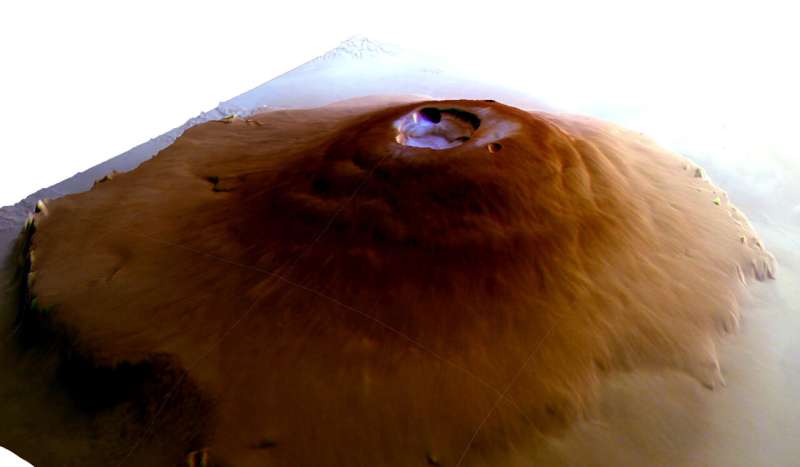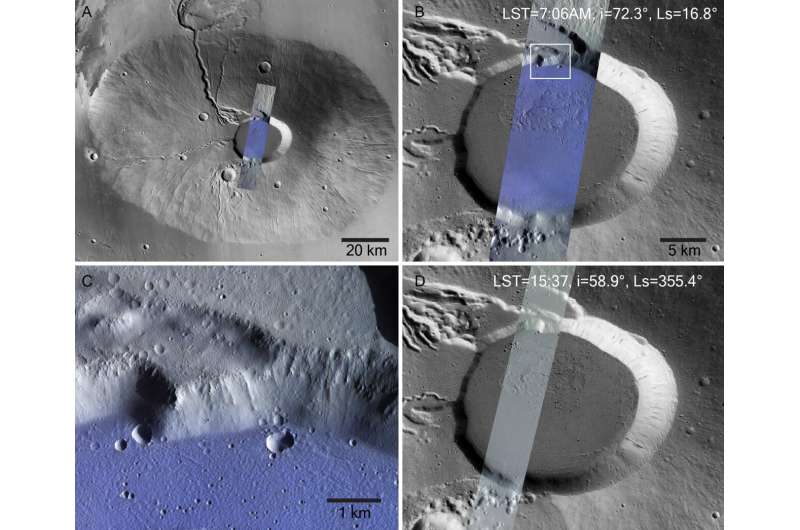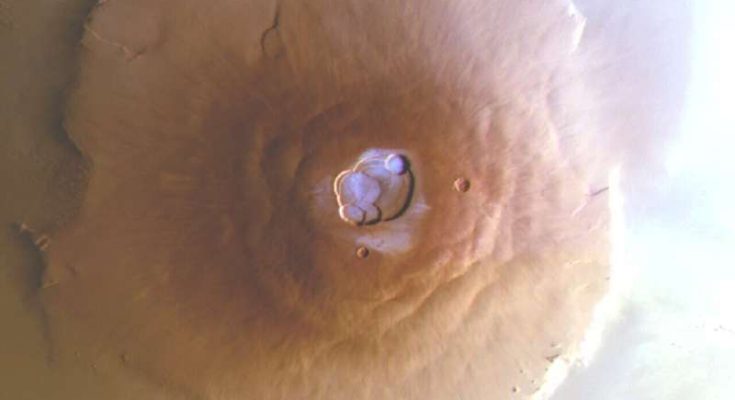For the first time, water frost has been detected on the colossal volcanoes on Mars, which are the largest mountains in the solar system. The international team led by the University of Bern used high-resolution color images from the Bernese Mars camera, CaSSIS, onboard the European Space Agency’s ExoMars Trace Gas Orbiter spacecraft.
Understanding where water can be found, and how it is transported, is relevant for future Mars missions and possible human exploration.
“ExoMars” is a program of the European Space Agency ESA: for the first time since the 1970s, active research is being conducted into life on Mars. On board the ExoMars Trace Gas Orbiter (TGO) is the Color and Stereo Surface Imaging System (CaSSIS), a camera system developed and built by an international team led by Professor Nicolas Thomas from the Physics Institute at the University of Bern. CaSSIS has been observing Mars since April 2018 and is delivering high-resolution color images of the surface of Mars.
Using these high-resolution color images, an international team led by Dr. Adomas Valantinas has been able to detect water frost on Mars. The study has just been published in the journal Nature Geoscience. Valantinas was a Ph.D. student at the Space Research & Planetary Sciences Department of the Physics Institute of the University of Bern until October 2023 and is currently a guest researcher at Brown University (U.S.) thanks to a Swiss National Science Foundation (SNSF) postdoc mobility fellowship.

An unexpected discovery
The frost was detected on the tops of Mars’ tallest mountains—the Tharsis volcanoes. These volcanoes are the tallest mountains in the solar system, with Olympus Mons towering up to 26 km above the surrounding plains. This frost formation had not been expected because these mountains lie at low latitudes near Mars’ equator.
“At these low latitudes, the high amounts of sunshine tend to keep surface temperatures high. Therefore, we did not expect frost to be found there,” Valantinas says. What is more, the thin atmosphere on Mars is inefficient at cooling the surface, so high altitude surfaces can get as hot as low altitude surfaces at midday, contrary to what happens on Earth.
Valantinas explains, “Upslope winds bring air containing water vapor up from the lowlands, and this air cools as it gets to high altitudes, causing condensation. This is a familiar phenomenon both on Earth and on Mars.” The same phenomenon causes the striking Arsia Mons Elongated Cloud—and the new study shows that it leads to morning frost deposits on the Tharsis volcanoes as well.
“As we could see from the CaSSIS images, the thin frosts are only present briefly, for a few hours around sunrise, before they evaporate in the sunlight,”

Successful collaboration
In order to identify the frost, Valantinas and the team analyzed more than 5,000 images made by the Bernese Mars camera CaSSIS. Since April 2018, CaSSIS has provided observations of local dust activity, the seasonal changes in CO2 ice deposits, and the existence of dry avalanches on Mars.
Thomas states, “That we now could detect the nighttime deposition of water frost on Mars at visual wavelengths and at high resolution is yet another proof of the impressive scientific capabilities of the Bern camera system.”
The discovery was validated by using independent observations by the High Resolution Stereo Camera (HRSC) onboard the ESA Mars Express orbiter and by the Nadir and Occultation for Mars Discovery (NOMAD) spectrometer onboard TGO.
Ernst Hauber, geologist at the DLR Institute of Planetary Research (DLR-Institut für Planetenforschung) in Berlin and co-author of the current study says, “This study nicely demonstrates the value of different orbital assets. Combining measurements from various instruments and modeling, we can improve our understanding of atmosphere-surface interactions in a way that wouldn’t be possible with one instrument alone.”
According to Hauber, the results also show how important the long-term monitoring of planetary processes is, as some phenomena only become apparent by comparing multiple measurements over time.
Important findings for future Mars missions
Despite being thin—likely only one-hundredth of a millimeter thick (as thick as a human hair)—the patches of frost cover a vast area. “The amount of frost represents about 150,000 tonnes of water swapping between surface and atmosphere each day during the cold seasons, the equivalent of roughly 60 Olympic swimming pools,” as Valantinas explains.
“Understanding where water can be found, and how it moves between reservoirs, is relevant for many aspects of Mars exploration,” Thomas says.
Of course, we want to understand the physical processes involved in the climate of Mars. But, in addition, understanding the water cycle on Mars is also of major importance for establishing key resources for future human exploration and to constrain the past or present habitability,” Valantinas concludes.
Provided by University of Bern





